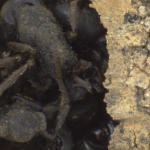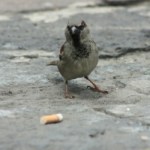nest
I came across this neat video summarizing a study that found some birds build nests near alligators to protect themselves from other predators. But the protection is not without a price.
Bone-house wasps protect their young by building walls made of ant carcasses. Image from: Merten Ehmig
A new species of spider wasp that protect their young with walls made of ant carcasses has been discovered in the forests of China. Dr. Michael Staab from the University of Freiburg discovered the new species which he named Deuteragenia ossarium meaning "bone-house wasp" since the wasps reminded him of the ossuaries in Europe with structures decorated from human bones.
Sedlec Ossuary in the Czech Republic. Image from Wikipedia.
Similar to the ossuaries, the bone-house wasps use alive…
House sparrow in Mexico City. Photo Credit: © Víctor Argaez
Researchers Suárez-Rodríguez et al., observed house finches (C. mexicanus) and sparrows (P. domesticus) on the National University of Mexico campus in Mexico City routinely pulling apart cigarette butts to obtain the filters. The birds were found to incorporate the filters in their nests leaving researchers to speculate the purpose of used cigarette butts. Using heating elements to attract parasites, they found that probes covered in "used", i.e. artificially smoked, cigarette butts attracted fewer…
tags: birds, Northern cardinal, Cardinalis cardinalis, ornithology, Image of the Day
Note the paper teabag wrapper in the photo. I think it adds a "New Yorkish touch" to its construction.
Nest of the Northern cardinal, Cardinalis cardinalis, located in a tree in the traffic circle in front of the Museum's parking garage.
Image: Bob Levy, author of Club George [larger view].
Did you notice the pale blue eggs in the nest?
Researchers in Florida poured a liquid plaster-metal mixture into the nests of the Florida harvester ant. The resulting casts display astonishing intricacy and depth. One interesting discovery was that the top heavy nature of the chambers reflects age distribution within the any colony and not necessarily earlier digging. Younger ants tend to dig within the bottom 2/3rds of the nest while older ants dig in the top 1/3rd, eventually graduating to harvesting outside of the nest. The highest concentration of ants, therefore, is in the top of the nests, resulting in more chambers.Although this…

